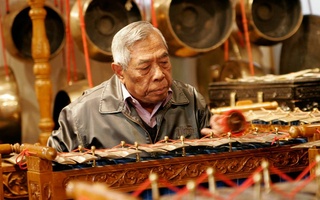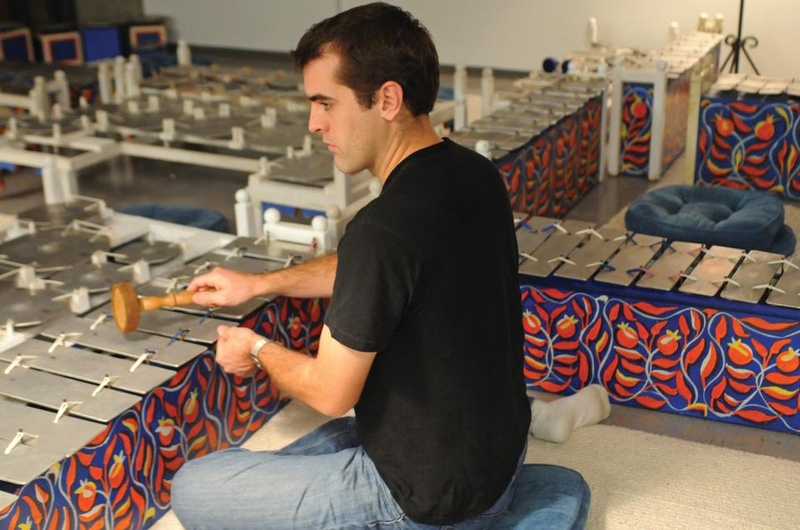Students, staff, and faculty from Harvard, as well as musicians from around the Boston area, convene every Thursday to sit shoeless on square blue cushions before large contraptions of wood and metal. In the Student Organization Center at Hilles (SOCH), they produce the hypnotic, cyclical, and resonant timbres of the gamelan. The presence of this gamelan at Harvard illustrates a general trend toward the academic study of world music in the music department.
The gamelan, pronounced GAH-meh-lahn, comprises metallophones, drums, gongs, xylophones, and occasionally vocals or other melodic wind instruments. This Indonesian orchestra reproduces the indigenous music of Bali and Java. Unlike a standard Western orchestra, however, each gamelan is unique—built as a specific, unified ensemble, with all instruments tuned in relation to one another. The music of the gamelan has several historical settings. For example, it was the royal court orchestra of Central Java, and provided music for Hindu temple festivals in Bali. In addition, the gamelan may accompany dance, drama, and shadow puppet theater.
Jody Diamond, Artist-in-Residence at the Harvard music department and founder of the American Gamelan Institute, has studied Indonesian music for the last 40 years. After first encountering the gamelan in the early 1970s at the California Institute of Art in Los Angeles, Diamond was struck by her new discovery. “I had no clue what these were,” she says. “It made me realize how much more there was to learn. It opened up a whole different world of music and musical ideas.”
Diamond traveled to Indonesia on a Fulbright Scholarship to survey contemporary Indonesian music, for which she interviewed composers. She later worked with prominent American composer Lou Harrison. In California, Harrison and his partner William Colvig built the gamelan currently housed at the SOCH. Upon his death in 2003, Harrison left the Gamelan Si Betty to Diamond, who began to look for its new home. According to Kay Kaufman Shelemay, several members of the music department were eager to have a gamelan at Harvard. Shelemay, then chair, is a professor of Music and African and African American Studies, as well as Director of Graduate Studies. Although there was a Balinese gamelan at the Massachusetts Institute of Technology and a Javanese gamelan at Tufts University, the music department faculty was excited to obtain Harrison and Colvig’s uniquely American gamelan.
Diamond directs a community ensemble that rehearses weekly, which serves to enrich Harvard’s culture with the rich sounds and complex rhythms of Indonesian music. “In what way is a gamelan a vehicle for us to discover another culture? In what way is it a place for creating music?” Diamond reflects.
Courses and graduate studies in ethnomusicology—generally defined as both the study of non-Western musical traditions and the study of music as culture—are becoming increasingly popular at Harvard. Last year, the music department introduced a new course as an extension to its tutorial sequence, Music 97c: “Music History and Repertory: Music in Cross-Cultural Perspective.” Taught in its first two iterations by Shelemay, this semester’s curriculum comprises units on the music of Ethiopia, the Middle East, and the Balinese gamelan. As part of the course, students will have the opportunity to gain hands-on experience with traditions of world music, including gamelan performance labs with Diamond and a winter session trip to Washington, D.C. to study the music of Ethiopian Christmas. Other courses on Iranian, Asian, and global pop music reflect the increasing demand for emphasis placed on world music.
Graduate students in ethnomusicology are required to conduct fieldwork, and current students have traveled or will soon travel to areas as disparate as Taiwan, Turkey, Sri Lanka, Suriname, Czech Republic, Brazil, Israel, and Cape Verde. “Ethnomusicology is a field that has come into its own in the last 25 years,” Shelemay says. “It’s a growing, lively field—that’s nothing to sneeze at. Especially in America, we have so many musical traditions, and it’s important to reflect that in our curricula.”
“The music department is taking a turn in the right direction,” says Noam J. Hassenfeld ’12, a religion concentrator. According to Hassenfeld, in previous years the primary academic focuses of the music department were music theory and history. However, there are now more opportunities for composition and performance. Hassenfeld, Music Director of both The Harvard Undergraduate Drummers and the Pan-African Dance and Music Ensemble, was first exposed to world music in his Expos class: “Sound, Noise, Music.” The course introduced him to the gamelan. “It kind of blew my mind,” he says. This past summer, Hassenfeld received an Artist Development Fellowship to study gamelan music in Bali. Although he acknowledges and appreciates how it has been incorporated into an academic setting, he wishes that world music would assume greater relevance in the college community. “[World music] is not a side dish, it’s definitely a main course,” he says.
These sentiments are consistent with Diamond’s goals. She hopes eventually to form a new music group for more sophisticated performers and composers of the gamelan, awhile continuing to direct the current community-oriented ensemble at the SOCH. “It takes a while to grow a gamelan program. The trouble is getting people to not see these instruments as toys,” Diamond says. “I’m here to show Harvard everything the gamelan can be.”
Read more in Arts
Donoghue Takes on the Voice of a Child in ‘Room’Recommended Articles
-
 Gamelan, Making Music in Hilles
Gamelan, Making Music in Hilles -
A Modern-Day Treasure HuntOn Saturday afternoon, the Faneuil Hall pub Ned Divine’s was buzzing with the chatter of young couples returning from a ...
-
Ed School Features Desegregation DocumentaryA new documentary catalogs the individual experiences of former Boston students, including some who were physically assaulted by protesters throwing rocks.
-
Research Advances Quantum NetworksHarvard scientists at the School of Engineering and Applied Sciences have succeeded in capturing light within diamond pillars embedded in silver, allowing them to release individual photons at a specific rate.
-
 "Titanic 3D": Drink Till You Sink
"Titanic 3D": Drink Till You Sink -
Zumbro Contributes at All Nine Softball PositionsThe Harvard softball team completed one of its group goals Friday by claiming a second straight title. But that wasn’t the only accomplishment achieved by the squad this year.














